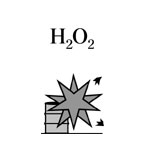| Case Name |
Explosion caused due to an overflow of aqueous hydrogen peroxide at a peracetic acid manufacturing plant |
| Pictograph |

|
| Date |
September 12, 1988 |
| Place |
Yamakita, Kanagawa, Japan |
| Location |
Chemical factory |
| Overview |
At a hydrogen peroxide (90%) measuring tank in a peracetic acid manufacturing plant, hydrogen peroxide overflowed due to negligence. The overflowing liquid entered the separator tank and the buffer tank for the vacuum pump, and an explosion occurred. The overflow occurred when an operator left the site with a valve remaining slightly opened. |
| Incident |
A 90% aqueous solution of hydrogen peroxide was being transferred from a hydrogen peroxide tank to a measuring tank by making a measuring tank vacuum using a vacuum pump at a peracetic acid manufacturing plant. The buffer tank at the vacuum pump inlet exploded. Peracetic acid was manufactured by mixing glacial acetic acid with 90% aqueous hydrogen peroxide. The reaction formula of this plant is shown in Fig3 for reference. |
| Processing |
Manufacture |
| Individual Process |
Charge and Feed |
| Process Flow |
Fig2.Schematic diagram
|
| Chemical Reaction |
(Oxidation) |
| Chemical Equation |
Fig3.Chemical reaction formula
|
| Substance |
Hydrogen peroxide, Fig4 |
| Type of Accident |
Explosion |
| Sequence |
During transfer of a 90% aqueous solution of hydrogen peroxide from a storage tank to a measuring tank using a vacuum pump, the operator left the site after adjusting the valve opening so that excessive transfer could not occur. He returned after 10 minutes and found that too much aqueous solution of hydrogen peroxide had been transferred. He adjusted the level of the measuring tank by transferring the excess amount to the separator tank. After the adjustment finished, white smoke came out of the buffer tank for the vacuum pump, and it soon exploded. |
| Cause |
An aqueous solution of hydrogen peroxide overflowed from the measuring tank (500 L) to the separator tank, and flowed into the buffer tank for the vacuum pump, into which generally nothing was expected to flow. Hydrogen peroxide reacted with foreign matter in the buffer tank, decomposed unexpectedly, and exploded due to the rapid pressure rise of decomposed gas. An aqueous solution of hydrogen peroxide was transferred by reducing the pressure in the tank, with associated liquid in a vapor phase from the measuring tank being separated in the separator tank. There seems to have been no inflow of aqueous hydrogen peroxide to the buffer tank downstream. |
| Countermeasures |
These facilities were abolished. Control equipment will be strengthened, appropriate materials for piping and tanks will be selected, and alarms and urgent measures for pressure release, etc. will be installed when a construction permit application is made in the future. |
| Knowledge Comment |
Structure of facilities that allows flowing of hydrogen peroxide (90%), which is a powerful oxidizing agent, into a vessel in which hydrogen peroxide is not expected to be used or stored is very hazardous. |
| Background |
1. The operator left his position, while transfer in the batch process was still underway. Doing more than two tasks simultaneously might easily cause an accident, and is generally prohibited. Although this could be called human error, it also could be a problem of education and training.
2. The risk of hydrogen peroxide entering the buffer tank was underestimated or not taken so seriously as to apply HAZOP, etc. Even the minimum requirement such as a level alarm at the measuring tank and automatic measurement of the feed flow rate was also overlooked.
3. The buffer tank contained foreign matter such as rust. The buffer tank design or operation was based on the premise that there is no inflow of the hydrogen peroxide. However, an inflow can occur by mistake during usual operation, so it is necessary to create an environment in which hydrogen peroxide will not explode in any case.
Considering the above, there seemed to be a problem in handling a 90% aqueous solution of hydrogen peroxide and also in facilities. |
| Incidental Discussion |
One of the causes of this accident was simultaneous parallel work. Many accidents due to simultaneous parallel work have been reported, therefore, special caution is needed to prevent an accident is this type of work. |
| Reason for Adding to DB |
Example of accident caused due to inadequate design of facilities and careless operation. |
| Scenario |
| Primary Scenario
|
Organizational Problems, Poor Management, Slackness of Management, Carelessness, Insufficient Precaution, Inadequate Handling, Ignorance, Insufficient Knowledge, Convincement, Planning and Design, Poor Planning, Poor Design, Regular Operation, Erroneous Operation, Irresponsible Operation, Bad Event, Chemical Phenomenon, Abnormal Reaction, Secondary Damage, External Damage, Explosion, Bodily Harm, Injury, 12 person injured, Loss to Organization, Economic Loss, Direct Monetary Damage 13 million yen
|
|
| Sources |
National dangerous object safety association. Vacuum tank exploded when measuring hydrogen peroxide (90%). 100 cases of accidents in dangerous facilities. pp.19-20(1991)
Masamitsu Tamura, Masahide Wakakura, Explosion at peracetic acid production plant. Reaction danger,- Accident case and analysis- p.47(1995)
|
| Number of Injuries |
12 |
| Physical Damage |
Walls and partition walls of a three-story building made of reinforced concrete collapsed, and windows blew away. A storage tank ruptured. |
| Financial Cost |
¥ 12 million (Fire and Disaster Management Agency) |
| Multimedia Files |
Fig4.Chemical formula
|
| Field |
Chemicals and Plants
|
| Author |
ARAI, Mitsuru (Environmental Science Center, The University of Tokyo)
TAMURA, Masamitsu (Center for Risk Management and Safety Sciences, Yokohama National University)
|
|